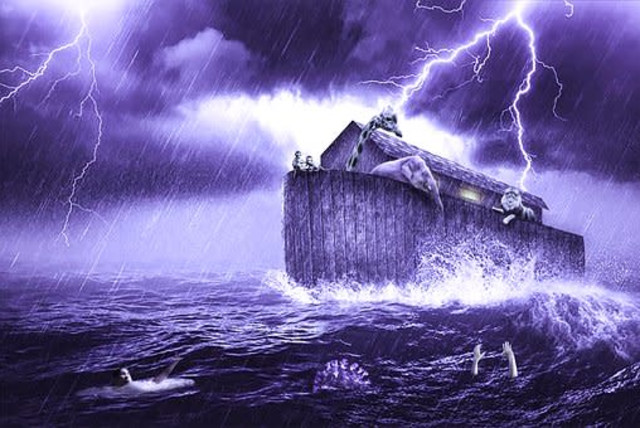Parashat Noah: Upholding the world

Our sages remind us that even in a time of chaos, our world relies on values and principles. Our learning, prayer, and good deeds can contribute to the stability of the world.
In Pirkei Avot (Ethics of Our Fathers), it is written: “On three pillars the world stands: on Torah, on service [to God], and on deeds of loving-kindness.” (1:2) This week’s Torah portion, “Noah,” tells of a time when the world was destroyed because these three pillars had collapsed.
According to Kabbalah, these three pillars correspond to three branches of the mystical tree of the Sefirot – the channels of divine energy that permeate all of existence and with which the world was created, namely, the sefirot of love, strength, and truth.
The pillar of kindness (on the right) corresponds to the sefirah of love. Acts of kindness allow the bounty of heaven to flow into the world, which could not exist without love. The sages proclaim: “A day without kindness is a day not lived.”
Since Oct. 7 last year, the pillar of kindness has been strengthened by myriad acts of kindness, and reinforced with the complete self-sacrifice of our holy soldiers.
The pillar of service (on the left) corresponds to the sefirah of strength, restraint, and focused energy. Once “service” referred to the sacrifices brought to the Holy Temple in Jerusalem. Without the Temple, service to God is achieved through prayer, which represents our reaching upward, toward the transcendent. Through the pillar of service, the world is elevated. In the book Baal Shem Tov al ha Torah, the chapter “The Pillar of Prayer” is dedicated to guidelines for prayer.
The pillar of truth (in the center) corresponds to Torah. Through the pillar of Torah, the physical (below) and spiritual (above) worlds are integrated.
By resting our actions on these three pillars, we become complete, enabling us to fulfill our purpose in this world, and providing a stable foundation for the world’s existence.
A history of destruction and recreation
Akin to our post-flood world, Yoram Raanan’s painting Three Pillars presents a history of destruction and re-creation.
Underneath Three Pillars is an earlier work that he painted over in a process captured on video. The earlier painting is seen in the opening sequence of the video, with its lower part appearing like a scene at the water’s edge, with two tiny black figures that seem to be engaged in confrontation.
In his transformation of the painting, Raanan turned the canvas 90 degrees and with bold vertical and horizontal strokes transformed the landscape into a structure of three pillars upholding a ceiling composed of rays of light.
The golden pillars in the painting were clearly not meant to depict physical pillars but metaphysical ones, since pillars are made of stone and not of gold. While grounded in physical, earthly reality, they soar upward to touch the heavens.
Beyond the pillars, a sky-blue doorway emerges, seemingly leading to another, distant realm – an invitation to step into a spiritual dimension.
Notice how the right pillar is surrounded by rays of purple, violet, and magenta which flow down around it. These colors reflect the highest ideals in humankind and stimulate our desire to benefit humanity. They express the passion to create, to produce a positive outpouring of energy.
The left pillar appears to be part of a heavenly blue doorway – the doorway of infinite possibilities of transcendence that can be accessed through prayer. Beyond the doorway, there is a suggestion of what awaits those who reach this goal: Off in the distance, another building can barely be discerned – perhaps it is a palace or a temple; perhaps the heavenly Jerusalem, the symbol of spiritual yearning.
The middle pillar – the pillar of Torah – corresponds to the sefirah of truth, which brings harmony, balance, and integrity to the world. In the painting, the middle pillar has a partially magenta background to the right and a blue background to the left, and it is balanced between the two. The middle pillar embodies both ascending and descending energies as in Jacob’s dream of a ladder reaching heavenward, upon which angels ascended and descended.
Sometimes, we feel that our world is falling apart and despair threatens. As the psalmist asks, “When the foundations are destroyed, what can the righteous do?”
However, our sages remind us that even in a time of chaos, our world relies on values and principles. Our learning, prayer, and good deeds can contribute to the stability of the world. ■
Meira Raanan is the author of The Art of Revelation: A Visual Encounter with the Jewish Bible, a commentary on the paintings of her husband, Yoram Raanan. She is also a teacher of Jewish meditation. Esther Cameron is a poet, scholar, and essayist living in Jerusalem. She is editor-in-chief of The Deronda Review.
Jerusalem Post Store
`; document.getElementById("linkPremium").innerHTML = cont; var divWithLink = document.getElementById("premium-link"); if (divWithLink !== null && divWithLink !== 'undefined') { divWithLink.style.border = "solid 1px #cb0f3e"; divWithLink.style.textAlign = "center"; divWithLink.style.marginBottom = "15px"; divWithLink.style.marginTop = "15px"; divWithLink.style.width = "100%"; divWithLink.style.backgroundColor = "#122952"; divWithLink.style.color = "#ffffff"; divWithLink.style.lineHeight = "1.5"; } } (function (v, i) { });

